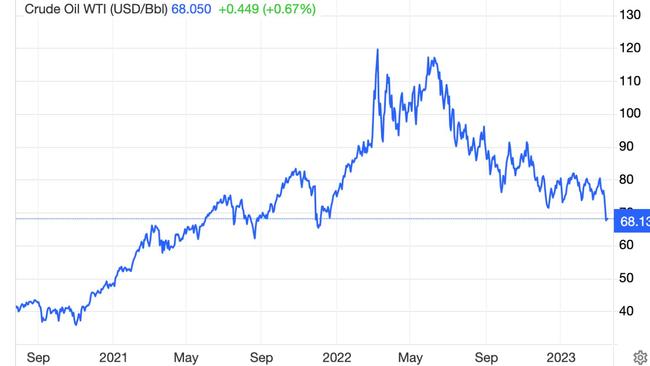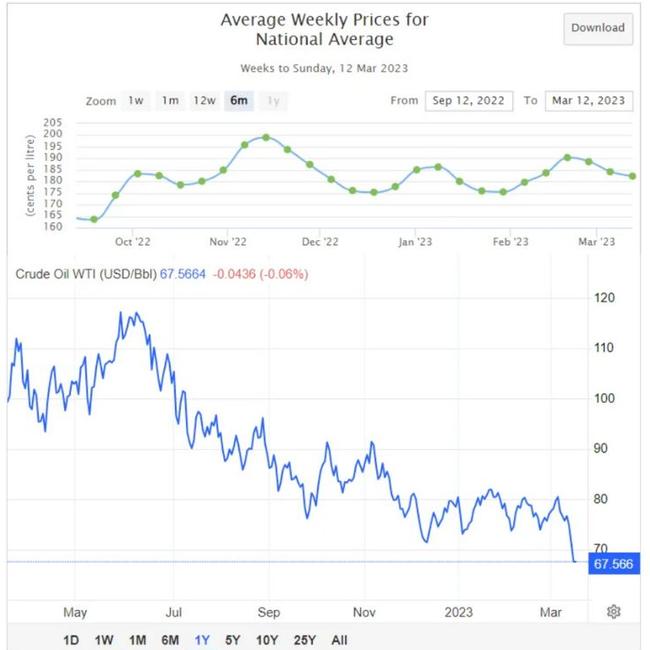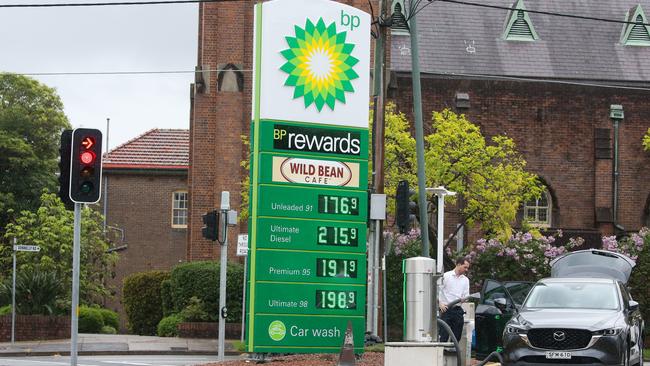‘Sick of getting ripped off’: Graph reveals troubling petrol trend that’s here to stay
An eagle-eyed driver has spotted an infuriating trend in a graph analysing the price of petrol, as Aussies continue to be slammed by the rising cost of living.
On the Road
Don't miss out on the headlines from On the Road. Followed categories will be added to My News.
Two graphs comparing the value of crude oil with prices at the petrol pump have Aussies fuming, as households continue to tighten their belts amid the cost of living crisis.
After analysing the global trading price of crude oil, one driver questioned why Aussies are still forking out a small fortune when the commodity’s price is at a 15-month low.
“Oil prices are at their lowest since December 2021 – why are we still paying $1.80 per litre for petrol?” the motorist asked online in a Reddit post that quickly went viral.

A national average weekly prices chart and crude oil trading economics graph accompanied the post to show how much Australians were paying for petrol versus the price the natural resource was selling for.
As of Friday, the trading price for crude oil was $US68.14 ($A102.25) per barrel, a slight drop from the month’s highest price to-date of $US80.43 ($A120.70) on March 6.
This figure is one of the lowest trading prices seen for the commodity since December 20, 2021 where its price was about $US68.19 ($A102.33).
But despite the commodity’s current low price, the cost of fuel in Australia was 182.3 cents per litre last week, according to the Australian Institute of Petroleum.
The difference in prices angered many online.

“We’re paying closer to $2.30 per litre in the eastern suburbs of Sydney. Like up 60c from last week. Explain that price hike, someone?” one commenter wrote.
“I’m sick of getting ripped off by everything as my wage is stagnant,” another said.
One person from Victoria said: “It’s f***ed how some places have completely different prices to other places.
“On the Mornington Peninsula it’s currently $1.65 per litre. Go closer to Melbourne, say Berwick, and it’s somewhere between $1.89 and $2.09 per litre. Why?”
While it may seem simple to assume petrol prices should drop if the commodity price has, there are quite a few reasons why this doesn’t happen.
Fuel prices are set by the market
There are three main factors which determine how fuel prices are set in Australia, the Australian Competition and Consumer Commission (ACCC) states.
These are weighing up market costs, the international benchmark prices, and keeping prices competitive with other sellers.
“International benchmark prices and the value of the Australian dollar have the most influence on the price consumers pay for fuel,” the ACCC said on its website.
“Pricing decisions by wholesalers and retailers, and levels of competition in different locations [also] influence fuel prices.”
Additionally, the international benchmark price is set in US dollars, so daily fluctuations in the value of the Australian dollar can affect the domestic price of fuel.

Price cycles
While it might not be obvious, the market’s cycle fluctuates in an up and down pattern across Australia’s largest capital cities.
If the cost of fuel steadily decreases for a period of time, it will most likely be followed by a sharp increase – also known as the petrol price cycle.
Drivers in Sydney, Melbourne, Brisbane, Perth and Adelaide will only notice this trend as it doesn’t occur in Canberra, Hobart or Darwin.
“Petrol price cycles are the result of pricing policies and not from changes in the wholesale cost of fuel,” the ACCC said.
Retailers need to account for own costs
The cost of fuel will usually be above the commodity price as retailers and wholesalers have additional costs they need to pay to sell the product.
About 90 per cent of petrol sold in Australia is imported, despite the country producing some crude oil domestically.
Most fuel sold across the nation comes from Singapore, with the rest sourced from Asian countries South Korea, China and Malaysia in addition to the US, Japan and Thailand.
Consequently, in addition to in-house expenses such as rent, utility bills and salaries, sellers must pay transportation costs which include wharfage, insurance, freight and storage fees.
“Wholesalers and retailers also need to make a profit so that their businesses can continue to operate,” the ACCC said.
This may include increasing prices to keep up with competition.
GST and excise duty fees can also impact the price of fuel.

How to get the most bang for your buck
As the cost of living crisis continues, there are a number of ways you can reduce the price of fuel while improving your vehicle’s fuel economy.
For those happy to shop around for their petrol, fuel comparison apps tend to be the first place to go when searching for the best prices.
There are a number of apps across the country that can assist with this including government apps NSW FuelCheck, MyFuel NT, FuelCheckTAS and FuelWatch available in Western Australia.
A number of third party apps also have this feature such as the 7-Eleven app, MotorMouth, myNRMA, Petrol Spy Australia and GasBuddy.
There are other ways to save on petrol through the way drivers use and maintain their vehicles, according to consumer advocacy group Choice.
This includes avoiding short trips, checking tyre pressure once a month, opening a window instead of using airconditioning and avoiding revving and speeding.
“Use the recommended fuel type. If you use regular unleaded in a car designed for premium, expect slightly lower performance and fractionally higher consumption,” Choice said on its website.
“Using premium unleaded in a car designed for regular may provide better fuel consumption in some newer vehicles, but it’s unlikely to offset the extra cost of the fuel.”
Originally published as ‘Sick of getting ripped off’: Graph reveals troubling petrol trend that’s here to stay





